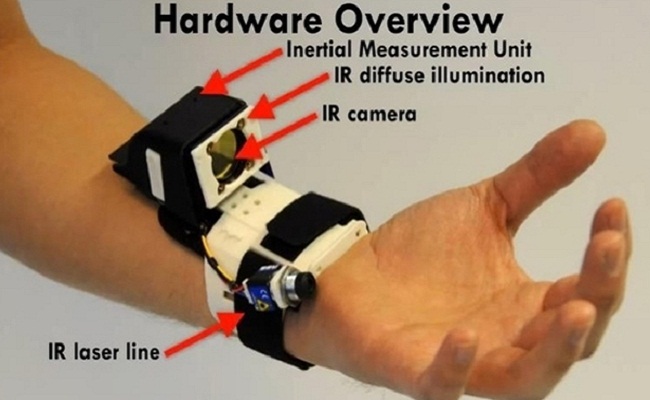This week, at the ACM symposium for User Interface software and Technology (also known as UIST) in Cambridge Massachusetts, Microsoft saw fit to unveil their latest piece of technology that they are currently researching. This little gadget has so much promise and potential that it’s kind of hard to structure an article around it. It has so many applications that finding a starting place is difficult, so I’ll start with the facts, and then we can discuss supposition.
The device is, at the moment named “DIGITS” and is so brilliantly simple, that it is a wonder that someone else has not designed and capitalized on the idea before. The device takes the form of a bracelet of sorts, but Microsoft refer to it as a gloveless interface. The structure of the device, even though it is still in it’s demo form is surprisingly simple, and already somewhat elegant, and it’s easy to see that it could very easily be shrunk down to a smaller size. In the demo video (which I will talk about shortly) they stress how simple the design is, and put a bit of emphasis on the fact that DIGITS is currently made using technology that already exists and is readily available to buy of the shelf. A strange move perhaps, given the chance that someone could independently invest and research their own version of the device. And we all remember how effective the Indy programmers were at using Kinnect better than its developers could. But besides that, the fact that the tech to make such a device already exists means that it would be cheap to produce, and people know this. So Microsoft would have to sell it at a relatively low price in comparison to the Kinnect to turn a profit
from consumers.
The team would like to reduce Digits to the size of a watch that can be worn all the time. We want users to be able to interact spontaneously with their electronic devices using simple gestures and not even have to reach for their devices.
So DIGITS itself is made up of an infrared camera, an infrared diffuser an infrared laser, as well as other motion track utensils, this hardware all works together to form a piece of motion detecting tech, which maps the position of the users hand and each individual finger, which its custom built software then transforms it into a usable input. So simply put, what ever gesture you make, DIGITS will map, copy and use alongside the proper command.
In the demo we see the user tune a radio and adjust the volume, we see him make a gun shape with his hand and play a rough FPS demo, he interacts with a tablet by pinching and zooming in the air as well as moving icons about the screen and at the end he answers his phone with a very casual thumbs up gesture.
So yes, we know that it can be used for gaming, but for once I find this to be rather boring. I find it boring, simply because, like I’ve already said, this piece of tech has so much potential that, if implemented correctly, it could help change the face of gaming as we knot it. Stick with me here, I’ve got a point to make.

We all know that you can use your usb Xbox 360 controllers to play games on your PC, that’s nice and handy. And thus far, we have only seen Occuls Rift being used alongside the Xbox 360 controller. But what if this fully 3D immersive world, was interactive? I’m fairly certain that by now, anyone who has been paying attention to the rift, has seen it being called the first step towards making the Holodeck. But up until now, it has been restrained by a controller as the UI. Imagine how much more amazing DOOM 3 would be if you had DIGITS working in conjunction with the Rift. The effect would be unlike anything else we have ever seen. Requiring you to type into a PDA with a hovering keyboard that could be represented similarly to the Dead Space inventory screen, right in front of your eyes. Remember those holographic locks on the doors in Mass Effect? Imagine the simple joy of passing your hand through it and seeing the door unlock before you. Would you not like to play through a game like Deus Ex Human Revolution with a new set of augmented eyes that pull up an overlay similar to the computers in Minority Report, allowing you to cycle view various depth perceptions, scan, locate, isolate and target weak points in a structure, or find a hair line fracture in the bones of your
enemy? With Assassins Creed slowly reaching into the modern times, would it not be interesting to see that the Assassins have used a piece of Eden to jump forward by decades in regards to technological advancement. So instead of using the bunching muscles of your forearm to extend a hidden blade, a simple gesture would allow the deployment of any number of pieces of equipment. Extend 2 fingers for a hidden blade, extend all the fingers of your hand to deploy smoke, a gun shape to employ the gauntlet mounted pistol, or even tapping your thumb to a finger, to activate a hot keyed item.
Like I already mentioned, this is supposition. It’s entirely possible that DIGITS never sees public distribution and although it has far more real life applications than in games, it would be sad to see something that has so much promise never come to light. The developers even know themselves that it has a plethora of applications that could make it the next big thing.
So cross your digits, and hope that this little marvel comes to life.


0 Comments